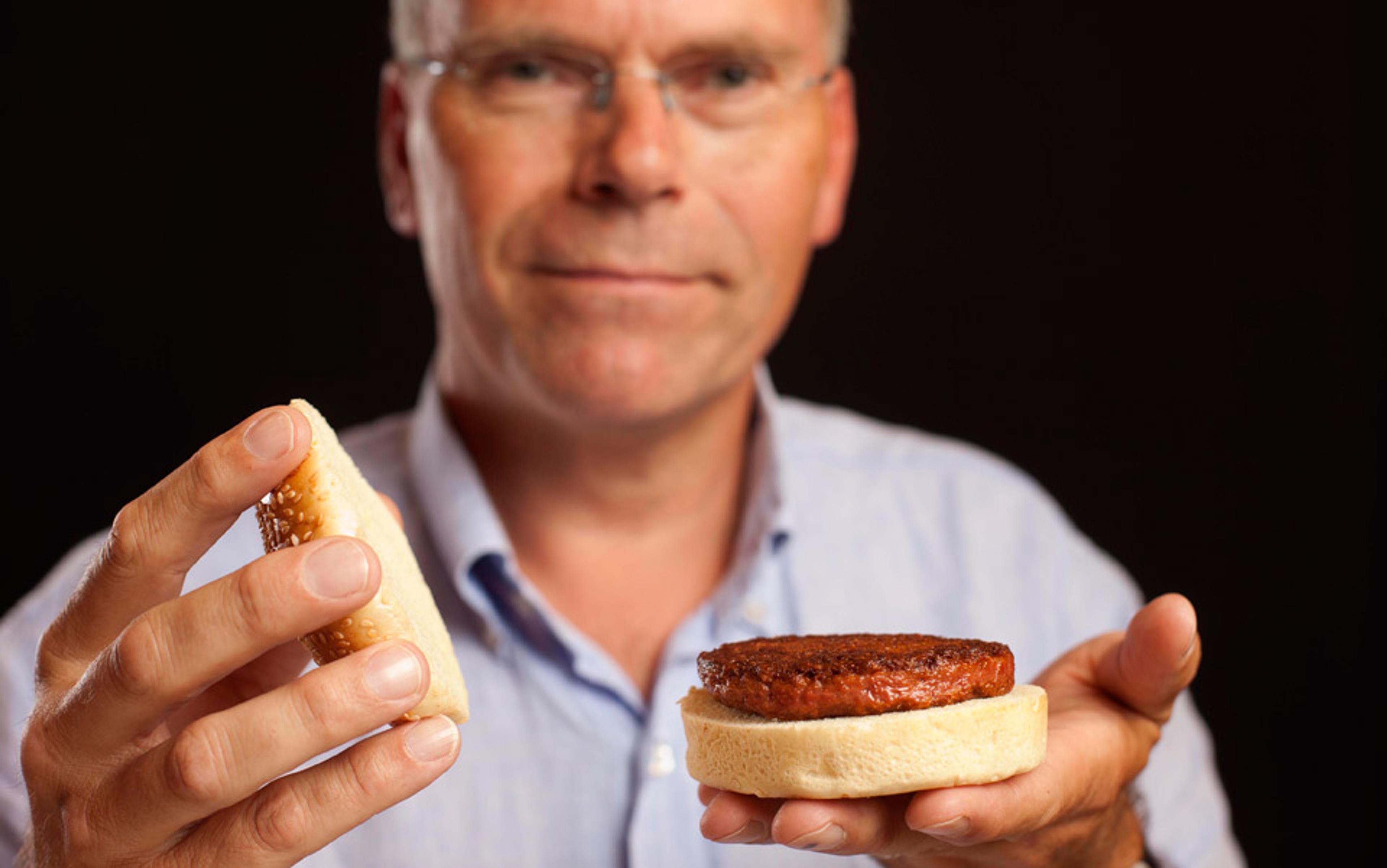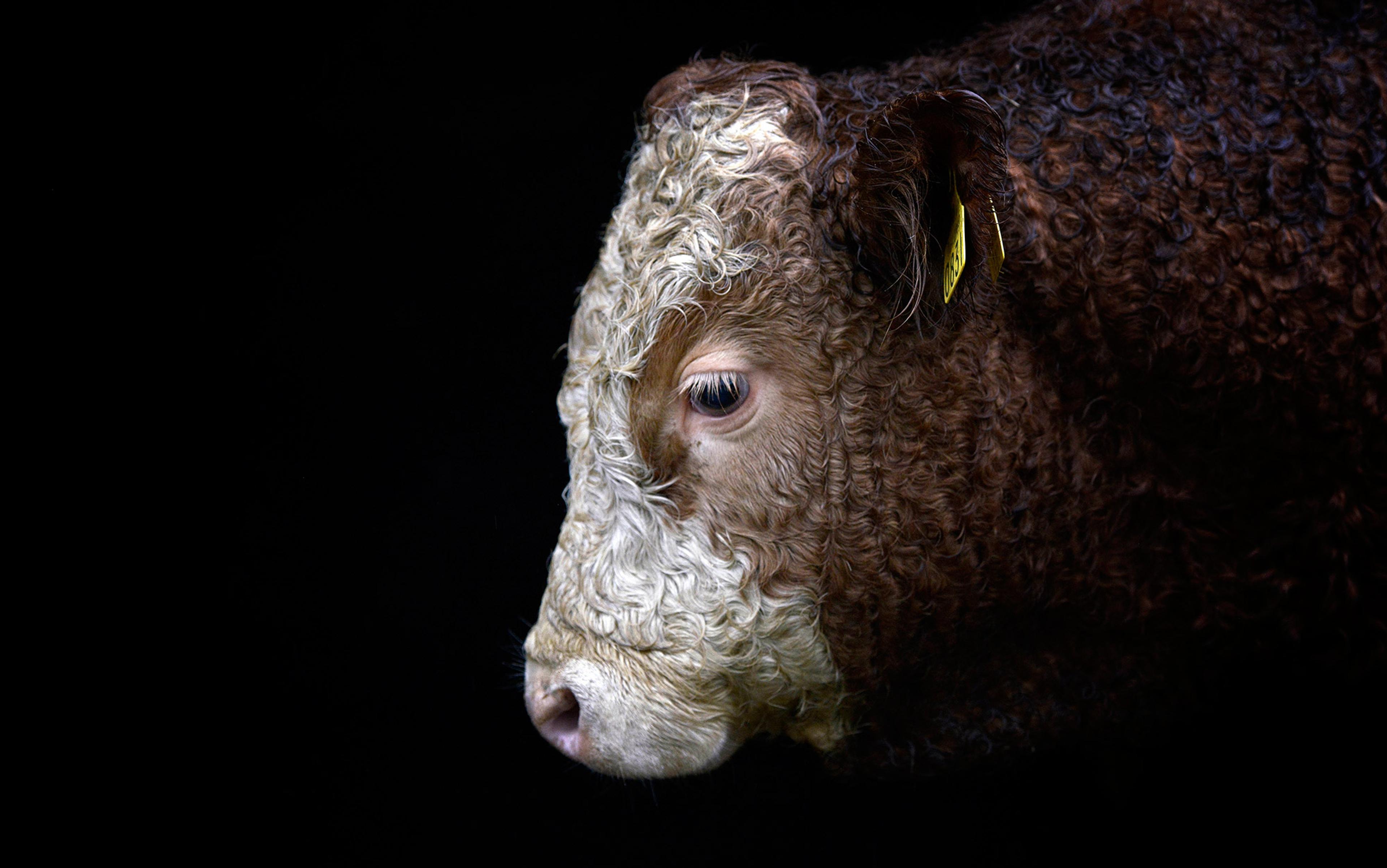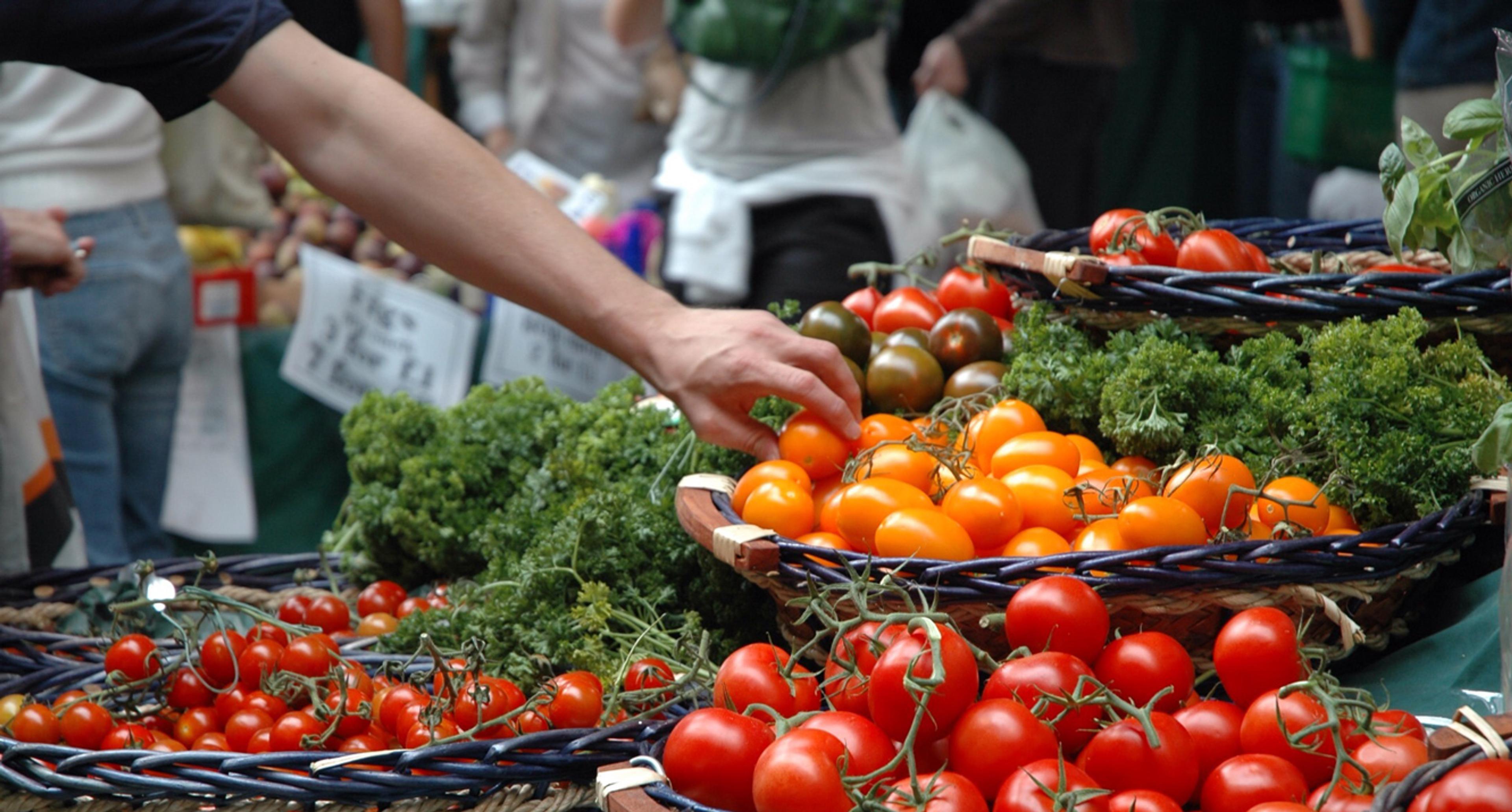The chef Richard McGeown has faced bigger culinary challenges in his distinguished career than frying a meat patty in a little sunflower oil and butter. But this time the eyes and cameras of hundreds of journalists in the room were fixed on the 5oz (140g) pink disc sizzling in his pan, one that had been five years and €250,000 in the making. This was the world’s first proper portion of cultured meat, a beef burger created by Mark Post, professor of physiology, and his team at Maastricht University in the Netherlands.
Post (which rhymes with ‘lost’, not ‘ghost’) has been working on in vitro meat (IVM) since 2009. On 5 August this year he presented his cultured beef burger to the world as a ‘proof of concept’. Having shown that the technology works, Post believes that in a decade or so we could see commercial production of meat that has been grown in a lab rather than reared and slaughtered. The comforting illusion that supermarket trays of plastic-wrapped steaks are not pieces of dead animal might become a discomforting reality.
The IVM technique starts with a harmless procedure to remove myosatellite cells — stem cells that can only become muscle cells — from a live cow’s shoulder. They are then placed in a nutrient solution to create muscle tissue, which in turn forms tiny muscle fibres. Post’s burger contained 40 billion such cells, arranged in 20,000 muscle fibres. Add a few breadcrumbs and egg powder as binders, plus some beetroot juice and saffron to give it a redder colour, and you have your burger. I was at the suitably theatrical setting of the Riverside Studios in west London to see the synthetic burger unveiled. The TV presenter Nina Hossain was hired to provide a dose of professionalism and glamour to what was in effect a live TV show, filmed by a substantial crew for instantaneous webcast.
When the lights dimmed, images of gulls flying over gentle sea waves were projected onto two screens by the sides of the stage. Over some sparse, slow, rising guitar chords, Sergey Brin, the co-founder of Google and a donor of €700,000 to Post’s research, uttered the portentous words: ‘Sometimes a new technology comes along and it has the capability to transform how we view our world.’ He was right. Never before has a human eaten meat without harming or killing an animal. But in a strange way the slick presentation detracted from the truly historic nature of the moment. A scientific landmark was sold to us in the manner of a glitzy product launch, a piece of corporate puff.
What was most striking to me was how the presentation led, not with science, but with ethics. As the introductory film continued, the scientist Ken Cook, founder of the US public health advocacy organisation Environmental Working Group, pointed out that ‘70 per cent of the antibiotics used in the United States now are not used on people, they’re used on animals in agriculture, because we keep them in such inhumane, overcrowded conditions’. He then reeled off a list of UN-backed statistics: ‘18 per cent of our greenhouse gas emissions come from meat production. We’re also using something like 1,500 gallons of water to produce just one pound of meat. Meat takes up about 70 per cent of our arable lands.’
Some might be surprised by this alliance: advocates of the most radical technological fix to our food supply agreeing with the critics of the contemporary industrialised food system — especially since the production of cultured meat tackles the problem by taking an even bolder technological leap forwards, rather than a step back to an older style of agriculture.
Dr Frankenstein is not supposed to also be an environmentalist who agrees that we must reduce land and water use, as well as synthetic inputs such as pesticides, fungicides, fertilisers, many of which depend more or less directly on oil for their production. The idea that IVM might have a part to play in a cleaner, fairer food system runs counter to a central idea put forward by many critics of industrial agriculture: that farming needs to be based more on traditional, natural, biological and ecological systems not artificial mono-cultures. Surely in vitro meat would be the most artificial mono-culture of them all.

Professor Mark Post of Maastricht University presents his ‘cultured beef’ burger. Photo by David Parry/PA
The belief that we have to choose between a food system that is over-dependent on technology and one that is more in harmony with nature rests on the assumption that there is a neat moral and conceptual contrast between ‘natural’ and ‘artificial’, and that this lines up neatly with the distinction between ‘good’ and ‘bad’. If IVM is the greenest, most animal-friendly meat, yet it is even more artificial than a pitiful, intensively reared broiler chicken, then no one can maintain the fantasy that bucolic nature has a monopoly on good, ethical food.
For those who have campaigned for a more ethical and sustainable food system, IVM is a good test of where their values really lie: with hard-nosed ethics or soft-focus sentiment. After all, it is hard for anyone concerned about the environment or animal welfare to disagree with Post’s claim that ‘from an ethical view [IVM] can have only benefits’. Cultured meat has the potential to replace lame, belching, farting, grain-guzzling, confined beasts with clean, safe, sustainable meat, direct from the factory floor.
Faced with this unsettling truth, how have greens and animal rights campaigners responded to Post’s synthetic burger? The environmental movement has generally been quietly, cautiously and moderately supportive, with chief executives leaving it to more junior colleagues to make low-key comments. Friends of the Earth International issued a short statement without fanfare in which its food campaigner Kirtana Chandrasekaran said: ‘It’s really positive that people are talking about alternatives to meat,’ but stressed that commercial IVM is a long way off and that ‘we can reduce our meat-eating now’.
Similarly, Emma Hockridge, head of policy at the UK’s Soil Association, conceded that ‘this new technology is interesting’, but emphasised how ‘there are also many simpler solutions to feeding our growing population available to us now’.
Greenpeace is more sceptical, issuing no statement on any of its global websites but telling the San Francisco Chronicle: ‘Synthetic meat distracts agricultural research and funding away from ecological farming, the real solution to the disastrous livestock model that causes environmental and socioeconomic crises and does not meet the dietary needs of the global South.’
While IVM remains a somewhat speculative and fringe issue, it is understandable that environmentalists remain cool about it, believing they have bigger fish to conserve. The animal welfare world, on the other hand, has responded more vocally and appears deeply divided on the issue. People for the Ethical Treatment of Animals (PETA) has bravely and unequivocally come out in support of IVM. ‘In vitro technology will spell the end of lorries full of cows and chickens, abattoirs and factory farming,’ says its most recent statement on the issue.
The UK’s Compassion in World Farming also gives Post’s breakthrough a cheer. ‘This could be a real game-changer,’ says its chief executive Philip Lymbery, ‘transforming the way meat is produced in ways which potentially come with great environmental, health and animal welfare benefits.’
Perhaps most strikingly, the philosopher Peter Singer, whose book Animal Liberation (1975) was a founding text for the modern movement, wrote in The Guardian: ‘I haven’t eaten meat for 40 years, but if in vitro meat becomes commercially available, I will be pleased to try it.’
The Vegan Society in the UK, however, worries that IVM will promote demand for meat and the stigmatisation of vegans by ‘perpetuating a myth that meat is and will always be intrinsically desirable’.
It’s hard to accept that sometimes two things we highly prize, such as animal welfare and conservation, can pull in different directions
The UK’s Vegetarian Society is more circumspect, but equally unwilling to welcome the developments. ‘Why go to this much trouble and expense to replace a foodstuff that we simply do not need?’ asks its chief executive Lynne Elliot.
Even Post conceded at the launch: ‘Quite frankly, vegetarians should remain vegetarians. That’s even better for the environment and for the animals than the cultured beef alternative.’ But interestingly, none of the objections raised by the two major UK vegetarian societies have anything to do with the two main ethical reasons for giving up meat in the first place: concern for animal welfare and the environment.
In resisting IVM, the societies seem to be reflecting the views of their members rather than following clear moral principles. In a poll run on the website of the Vegetarian Society, nearly four in five said they would not eat IVM, while fewer than 7 per cent said they would. But why should there be such reluctance among vegetarians (who, for the purpose of this argument, I’ll take to include vegans) to welcome IVM when, from an animal-welfare point of view, it is nothing other than good news? Even if it doesn’t turn out to be commercially viable, the case for cultured meat rests very heavily on the unacceptability of intensive animal farming, and so shines a light on the ethical objections to the meat industry.
The only logical way to make sense of the reluctance of many vegetarians to back IVM is that their choices are not as driven by animal welfare and environmental considerations as we — and they — assume. Perhaps a distate for eating meat is a visceral feeling that is only loosely connected to a ethically motivated imperative not to cause undue suffering to animals. Many people cannot distinguish between their ‘all-things-considered’ moral judgment and their unmediated gut feelings, mistaking reflex revulsion for ethical insight. Ingrid Newkirk, the president and co-founder of PETA, is refreshingly free of this confusion, which is perhaps why she can welcome IVM, even though she would not eat it. ‘Any flesh food is totally repulsive to me,’ she told NBC News. ‘But I am so glad that people who don’t have the same repulsion as I do will get meat from a more humane source.’
All of us, not just vegetarians, are at risk of confusing our base disgust and distaste with high principle. ‘Natural’ food feels right, ‘synthetic’ food feels wrong, so we are all-too-quick to dismiss the evidence that lab meat might be a good thing after all. And if you’re motivated to find the evidence that supports your gut feeling, there’s plenty from which you can pick and choose. But there is a huge difference between building your position on a firm evidence base and building an evidence base to support your position. We might believe our moral reasoning is evidence-led, but more often than not, we find ourselves led only to the evidence that conforms to our existing views.
The biggest obstacle to a more nuanced view of food ethics might be that it is so difficult to accept that ethics is not just about choosing between the good and the bad, but balancing different, competing goods. IVM highlights how there are several different desiderata for good food, and you can’t have all of them all of the time.
We want food to be delicious, diverse, healthy, affordable, sufficient for everyone, environmentally sustainable, good for animal welfare, from farms that make the countryside more attractive and use as few chemicals as possible. Many of these values are in conflict with one another for much of the time. For example, ugly fields covered with polytunnels can produce tasteless but plentiful, cheap, environmentally friendly and nutritious vegetables. The tastiest, most cow-friendly outdoor reared beef is too expensive to feed the majority, and can produce more greenhouse gasses and use more land than that from intensively reared cattle. There are some crops for which yields are so much better if grown non-organically that it makes no rational sense to avoid using pesticides and herbicides that are well within safe levels. IVM is just the most recent, vivid example of how our desire for the natural, traditional and aesthetically appealing food can clash with the value we place on animal welfare, environmental sustainability and the humane imperative to feed the whole world well.
Almost all the coverage of IVM has glossed over this pluralism, presenting commentators as either for or against, period. Perhaps that’s because balancing competing goods on a case-by-case basis is difficult, and we’d much prefer the simplicity of arranging them in a hierarchy, so that we always know what trumps what. It’s just too hard to accept that sometimes two things we highly prize, such as animal welfare and conservation, can pull in different directions. We easily fall prey to the philosophical myth that the good is unitary and whole, rather than plural and fragmented. We need to accept that most of the time ‘one can only gain one value at the expense of another, that whatever one chooses entails the sacrifice of something else’ as the political theorist Isaiah Berlin put it so eloquently in one of his letters.
We need to reach a point where we are neither romantically devoted to traditional, small-scale farming methods nor addicted to technological fixes
The challenge of IVM remains more theoretical than real for now. The two volunteer tasters at the launch were reasonably positive about the end product, but IVM clearly has a long way to go before it can compete with real mince for taste, while copies of proper cuts such as steaks and chops are nowhere near being made. Hanni Rützler, an Austrian food scientist, praised the ‘perfect’ consistency and ‘intense taste’, but found it ‘not that juicy’, due to the failure to grow fat, and that it needed more seasoning. Josh Schonwald, author of The Taste of Tomorrow (2012), said it had the mouth feel of meat, but he too was underwhelmed by the flavour.
More fundamentally, it is not yet clear that IVM could become a viable commercial proposition. Post’s team makes it sound as though the process is essentially simple, as though there isn’t much for the scientists to do. He describes how the cells ‘start dividing on their own’ and ‘naturally merge, arranging themselves into small myotubes’. By this process, ‘a few cells can become 10 tonnes of meat’. But given that Post himself doesn’t see commercial production being possible for another 10-20 years, clearly the process is much more difficult than this makes it sound.
Part of the challenge is scaling up to industrial production. Christina Agapakis, a synthetic biologist at the University of California, Los Angeles, captured the scepticism of many in the scientific community about this when she wrote in a blog for Discover magazine in April 2012 that ‘scaling is the deus ex machina of so many scientific proposals’, though often dismissed as simply an ‘engineering problem’. She points to many technical problems that scaling-up will require which no-one yet knows how to solve.
At the launch, I put some of these doubts to Post, who responded by pointing out that they had come this far in only a few years with a team of three or four people. That, he says, ‘already attests that we can come up with a viable solution within 10 years’. But progress is rarely linear and you cannot simply project where you will be in the future by drawing a graph of how far you have come to date and continuing the line.
Whether or not IVM fills a gap in the food supply, other technologies are coming along that will. Indeed, some already have. Golden Rice is a β-carotene-enriched genetically modified variety to help counter vitamin A deficiency in the developing world, developed not by Monsanto for profit, but by a humanitarian group funded by the Rockefeller Foundation. Meanwhile, aeroponic systems allow crops to be grown efficiently in a nutrient-enriched mist, without the need for any soil or growing medium. That is why the ethical conundrum of IVM is important, whether or not the product itself becomes commercially viable.
Of course we would be right to be cautious before buying into the often exaggerated claims made for the latest science, which is often based more on promissory than delivery notes. Suspicion of the claims of science to solve our food problems is well-grounded, as long as it does not descend into knee-jerk dismissals. But to forsake the benefits of any radical technological development because we are trapped in an overly simplistic, singular view of what good food means would be a terrible mistake. Science is not the answer to all our prayers but it has to be part of the answer to our food supply problems.
We need to reach a point where we are neither romantically devoted to traditional, small-scale farming methods nor addicted to technological fixes. We have to be able to determine the roles of both. As John P Reganold, professor of soil science and agroecology at Washington Sate University, put it when assessing the merits of organics: ‘a blend of farming approaches is needed for future global food and ecosystem security’. There are many ways in which food can be good or bad, and we cannot afford to pretend that we can get all that we want without getting some of what we don’t. Just as a healthy body needs a balanced diet, so a healthy attitude to food production means balancing different goods and not allowing one to become the master virtue, denying the claims of all others. Like children who are told to eat up their greens, we have to accept that we sometimes have to swallow things that we find unpalatable, for our own good and that of the world.






